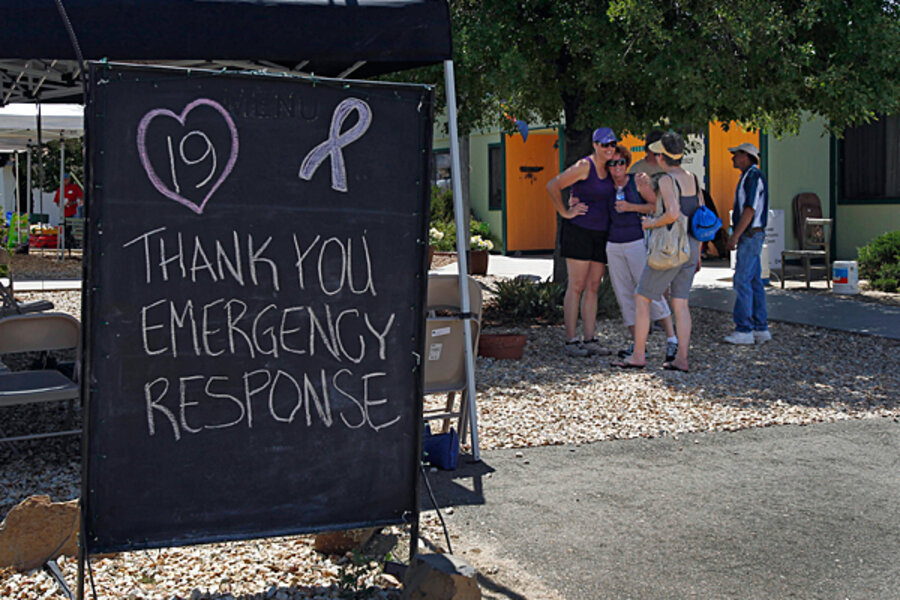Yarnell fire: How to save lives as wildfires intensify in Arizona and beyond?
Loading...
| Boulder, Colo.
The Yarnell Hill fire in Arizona may have been the most devastating loss of life for wildfire firefighters in 80 years, but the conditions that led to it – hot and dry, sustained drought, a prolonged buildup of fuels due to fire-suppression policies – are making such devastating fires increasingly common.
Climate change and decades of fire suppression are the major factors contributing to a rapid increase in the size and severity of fires in the West, say experts, and the growing number of homes in fire-prone areas – often known as the wildland-urban interface – has made fighting and preventing such fires even more complicated and costly.
As friends, family members, and fellow community members celebrate the lives of the 19 members of the Granite Mountain Hotshots who died at Yarnell Hill in a memorial service Tuesday, many people are wondering how to prevent such tragedies in the future – especially given the current trends.
“There has literally been an order-of-magnitude increase in the size of fires throughout the West, and in particular the occurrence of so-called mega-fires – those that burn a half a million acres or more, and used to be extremely rare, but are now becoming more common,” says Don Falk, a professor at the University of Arizona’s School of Natural Resources and an expert in fire history.
The fires, which are increasing in intensity and severity as well, are becoming more destructive. Along with the devastating loss of life at Yarnell Hill, this year has also seen the most destructive wildfire in Colorado history in terms of number of homes lost. More than 500 structures were destroyed in the Black Forest fire near Colorado Springs in June. The previous record in Colorado had been held by last year’s Waldo Canyon fire, which destroyed almost 350 homes.
What caused the deaths in Arizona has yet to be conclusively determined, but the preliminary report states that the firefighters “were entrapped when flames overran their position,” and described “extreme” fire behavior “with heavy winds.”
“All signs are pointing that these are going to become more common events,” says Mitch Tobin, editor of EcoWest.org, which tracks trends on a number of Western environmental issues, including fires.
While fire activity varies year to year, tracking he’s done since 1987 shows that while the average number of wildfires in the West has remained relatively steady, the total number of acres burned and the size of fires have been climbing steadily.
At the same time, the fires are increasing in intensity and severity.
“It used to be that the high-severity patches – meaning trees are killed and the soil severely damaged – covered a few hundred up to several thousand acres,” says Professor Falk. “Now we see patch sizes of tens of thousands of acres. It’s kind of a game changer.”
Most fire experts agree that what’s most needed is a program to get rid of the built-up fuels, whether through controlled burns or “mechanical” thinning – but getting the funding, approval, and political will to do so is hard.
“We have to do something to reduce the fuels,” says Dugger Hughes, a battalion chief for the Northwest Fire District in Tucson, Ariz., who directs the district’s wildfire-fighting efforts.
The sort of mechanical reduction that is needed around communities with a lot of homes in fire-prone areas is expensive, he notes – often more than $500 an acre – while prescribed burns can be done for about $5 an acre.
But even when prescribed burns can be done safely, he says they often get shut down right away because someone nearby complains about the smoke. And just getting the go-ahead for the burns – particularly given limitations under the Clean Air Act – can be difficult, time-consuming, and often sucks up much of the resources.
“If you’re doing 100 or 200 acres of fuels treatment a day, because that’s all you’re allowed to do, you’re never going to get over the hurdle,” says Mr. Hughes. “At some point we’re going to have to be allowed to do some large-scale burning, at a time of year where there will be an inversion effect, and there will be smokeshed. Somehow we have to get past that.”
Hughes and others also say there may have to be a reassessment of how much effort is expended to save buildings – right now, the top priority of most wildfire-fighting efforts.
“In the wildland arena, we put all our emphasis on saving structures,” Hughes says. “We need to back off on that.… We don’t risk a life to save a property.”
The increased spread of buildings in that wildland-urban interface is another major problem. In the past decade alone, 2.2 million new housing units have been built in that interface throughout the West, says Falk.
That increasingly populated landscape, he adds, makes controlled burns trickier and “creates a new imperative [to fight fires] that didn’t exist.”
“Even though in theory we understand perfectly well what to do, politically it’s almost impossible to do, because we have so many houses scattered over the landscape that we’re in fire-suppression mode 95 percent of the time,” Falk adds.
He hopes that, eventually, there may be some controls over who can build in such fire-prone zones, the same way that policies these days limit building in flood zones, for instance.
“You could define firesheds the same way you define a 20-year flood zone,” determining, on a county-by-county basis, areas where it’s dangerous to fight fires and where building should be limited, Falk says. “I don’t know whether we’re ready to have this conversation yet, but clearly we’re not going to break out of this vicious cycle until we do.”








